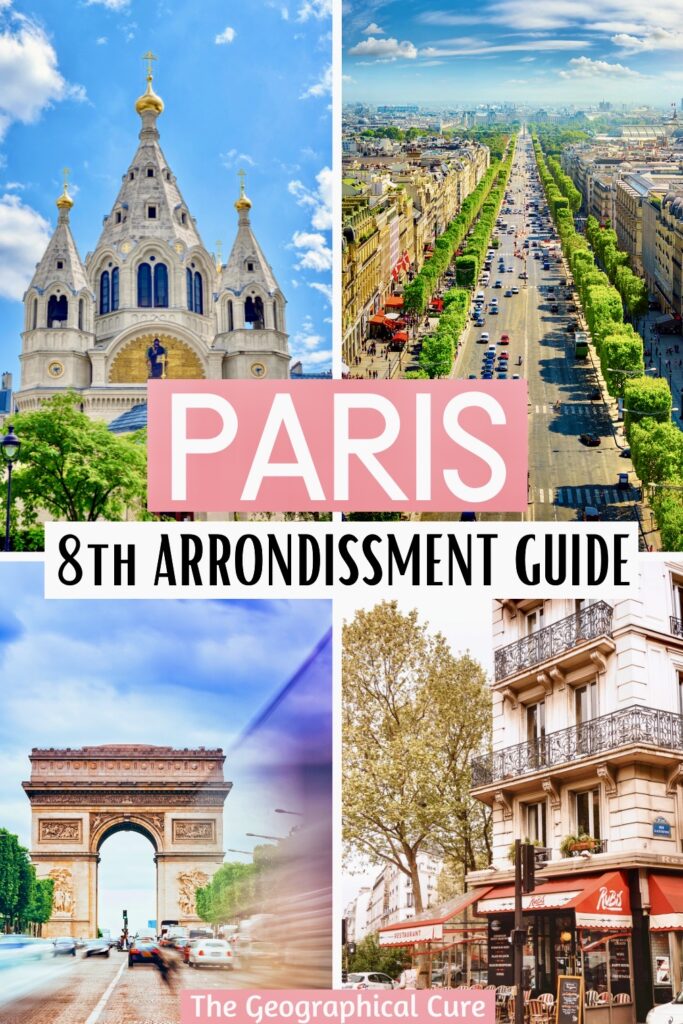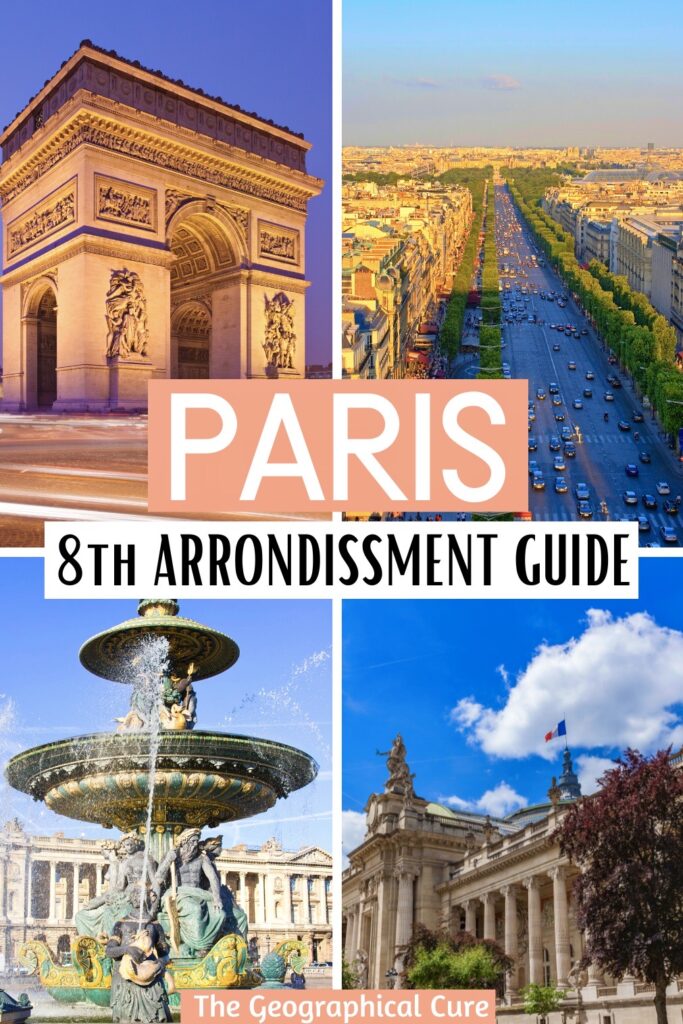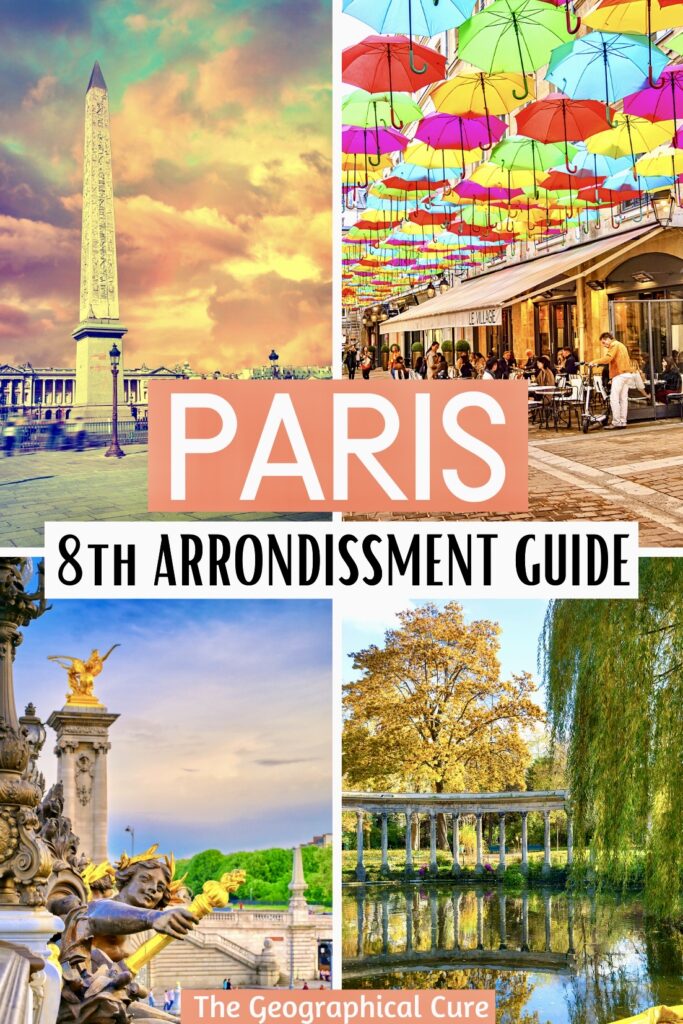The 8th arrondissement is on Paris’ Right Bank. It’s extremely elegant and home to an array of landmarks, cultural sites, and luxurious avenues.
Last time I visited Paris, I stayed in the 8th and it exceptionally convenient for sightseeing.
Here’s my rundown of all the things you can do in the 8th. Whether you’re a first-time visitor or a seasoned traveler, you’ll find plenty to marvel at in this distinguished and vibrant part of the city.
Best Things To Do In the 8th Arrondissement
1. Arc de Triomphe
At the western end of the Champs-Élysées stands the Arc de Triomphe, one of Paris’s most iconic monuments.
Commissioned by Napoleon after his victory at Austerlitz, it honors those who fought and died for France in the French Revolutionary and Napoleonic Wars.
The architecture is the Greco-Roman style Napoleon liked. Four large reliefs on the arch’s pillar commemorate his victory at Austerlitz in 1805.
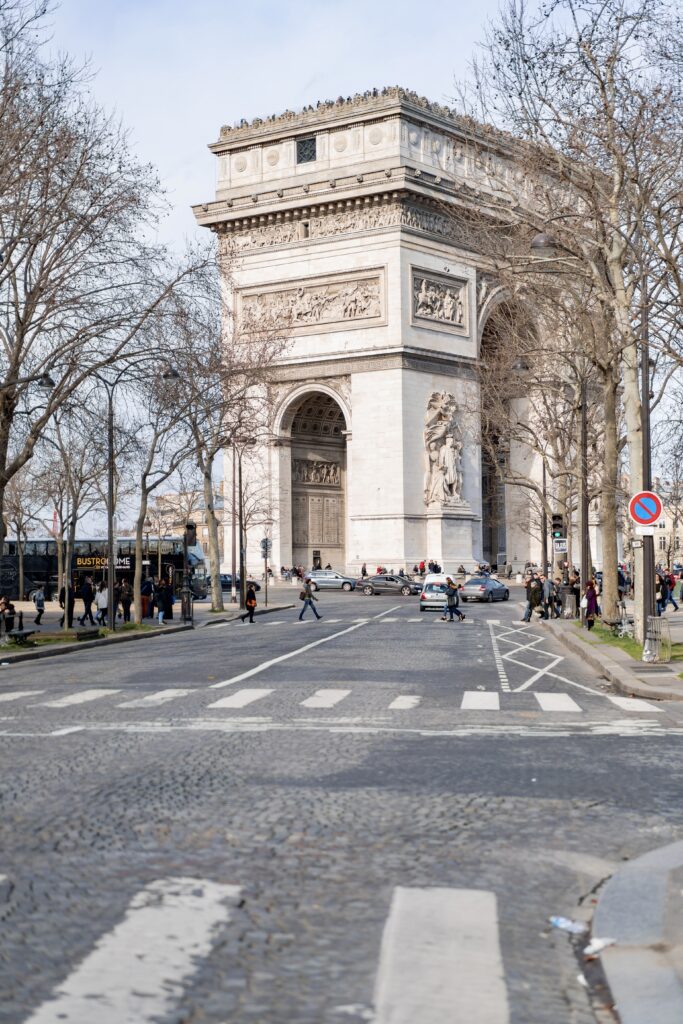
The arch is on the Place Charles de Gaulle. You can’t cross it. You must use the underground passageway on the Champs Elysées, which you can’t miss.
First, pay your respects to the tomb of the unknown soldier on the bottom level. Then, climb to the observation deck. You’ll have to go through security.
You’ll also need to pre-book a skip the line ticket to avoid waiting in a long line. It’s 284 steps up to the viewing terrace. (There’s a resting space halfway.)
From the top, you’ll have beautiful views of the Eiffel Tower and the Champs Elysees. The best time to go is sunset.
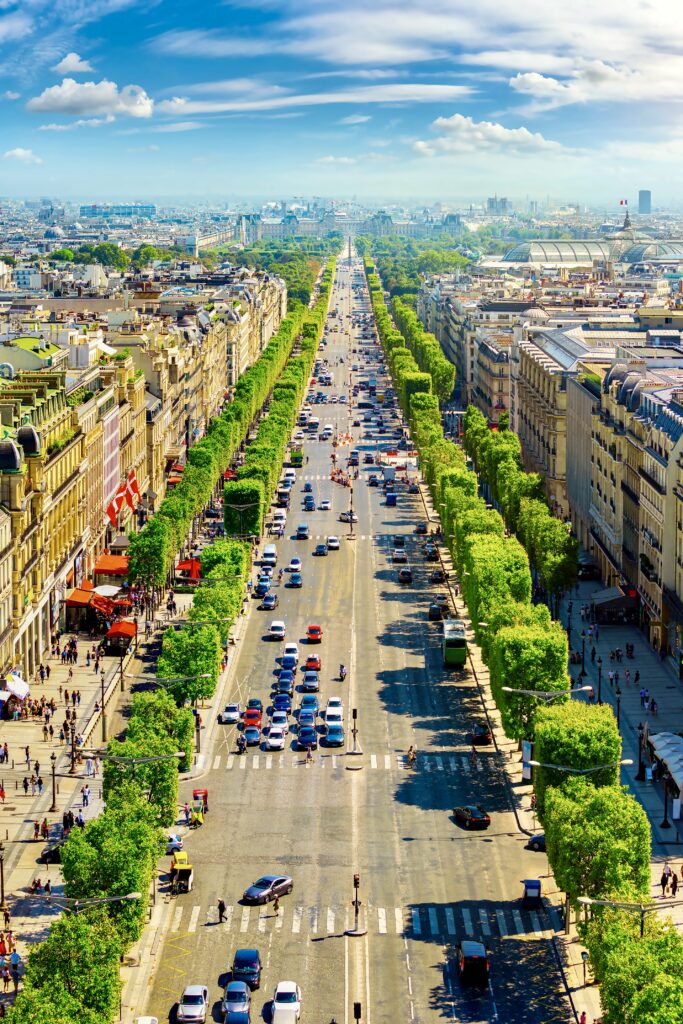
2. Champs Elysées
The Champs Elysées is the world’s most famous street and the spine of the 8th arrondissement. Clocking in at just 1.2 miles, it stretches from the city’s largest square, Place de la Concorde, to the Arc de Triomphe.
It’s not the most Parisian of Paris’ grand boulevards. There’s an international flair now. Still, it’s a must do stroll in Paris, especially for first timers.
The Champs Elysées is renowned as a shopping mecca. You’ll find all the high end stores and retail chains, including the Louis Vuitton flagship store. And they’re open late, if you want to do your shopping at night.
If you want to see it all, you can book a 2 hour guided walking tour.
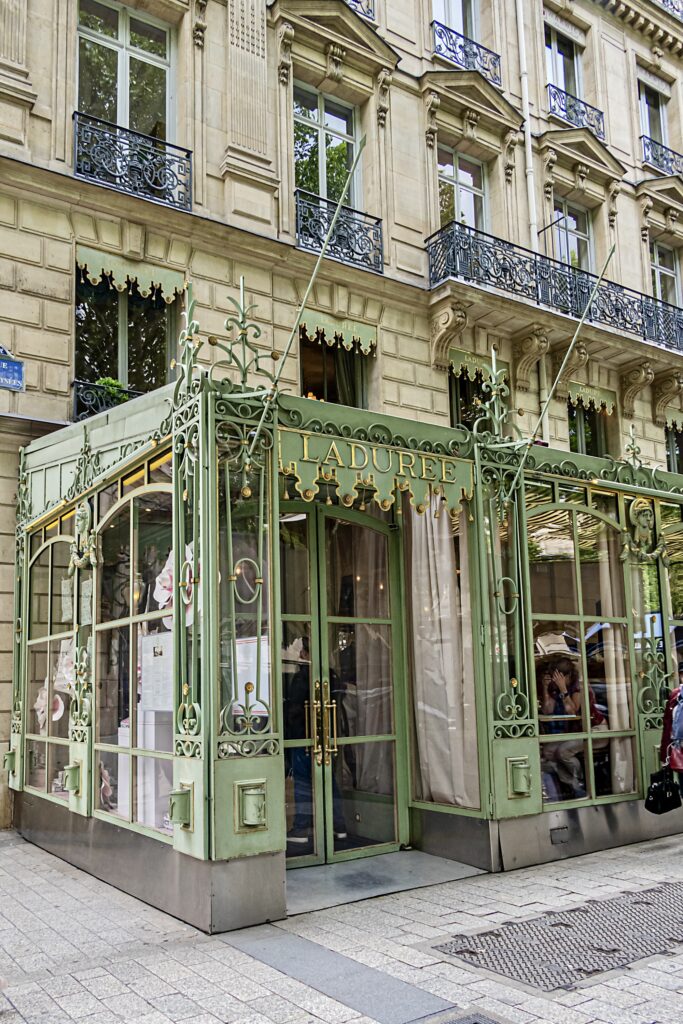
During the holiday season, the boulevard is spectacularly illuminated. The trees are draped with twinkling lights and colorful decorations are strung across the street.
If you want to stop at a chic cafe, I recommend Laduree. Opened since 1862, it’s a beautiful tea salon where you can eat inside or outside. The salon is known for its macarons.
Just off the Champs Elysées is Avenue Montaigne. It’s one of Paris’ most exclusive street, home to art galleries and the top French designers like Dior and Chanel.
3. Musee Jacquemart André
The Jacquemart-Andre is a hidden gem museum in the 8th arrondissement. It’s an opulent house museum housing a collection of old masters amid luxe period furniture.
The museum boasts an enviable collection of works by Rembrandt, Boucher, Nattier, Chardin. In the “Italian museum,” you’ll find sublime pieces by Botticelli, Mantegna, Canaletto, and Bellini.
Some of stand out masterpieces include a Tiepolo fresco at the top of the grand staircase, Paolo Uccelo’s St. George and the Dragon, and Sandro Botticell’s Flight Into Egypt.
For more information on what to see at this uber elegant museum, here’s my complete guide to the Jacquemart Andre. Click here to book a skip the line ticket.
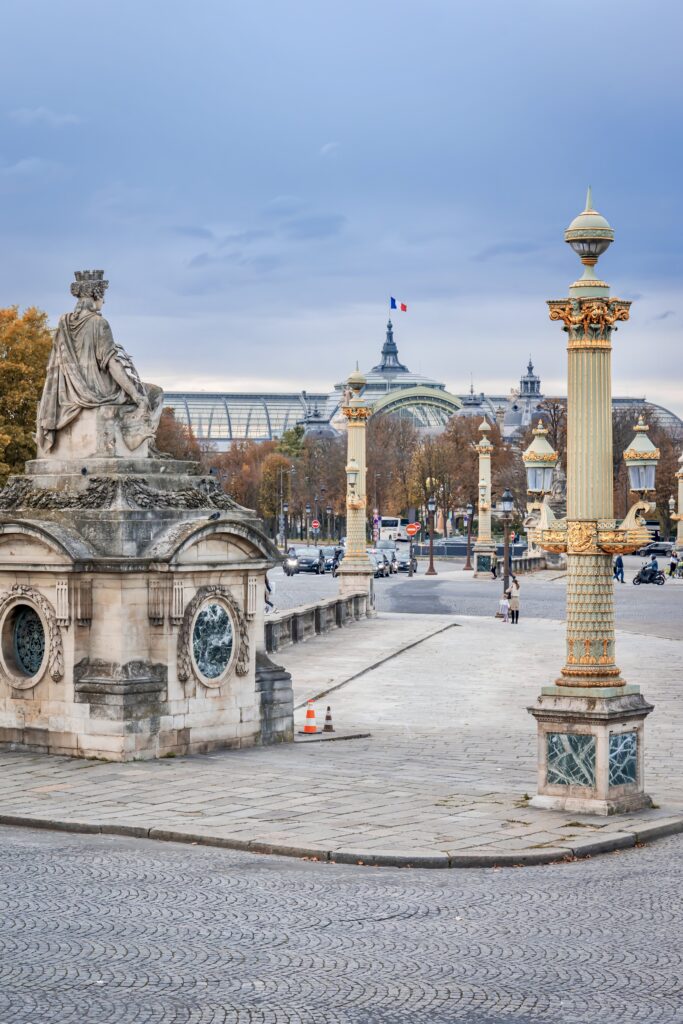
4. Grand Palais
The Grand Palais is one of Paris’ premiere art exhibition spaces. Like the Pont Alexandre III, it was build for the 1900 World Fair.
It’s a beautiful mixture of steel, concrete and glass. The enormous glass ceiling and dome are the most impressive. Two monumental bronze chariots with flying horses crown each end of the facade.
Inside, there’s an incredible lofty exhibition hall, which almost seems like a greenhouse. At night, the glass roof glows, lit from the inside.
The west wing houses a science museum with a planetarium. The east wing is reserved for high profile blockbuster art and photography exhibits.
5. Petit Palais
Like its sister palace, the Grand Palais, the Neo-Classical Petit Palais was built for Paris’ 1900 Universal Exposition. It was designed in the glamorous Beaux Arts style by the famous Parisian architect Charles Girault.
The sumptuous interior is filled with sculpted stucco work, frescoed ceilings, mosaic floors, and wrought-iron railings and staircases.
The Petit Palais has a delightful permanent collection that’s free to visit. The museum houses French paintings, sculpture, and artifacts from antiquity to the early 20th century.
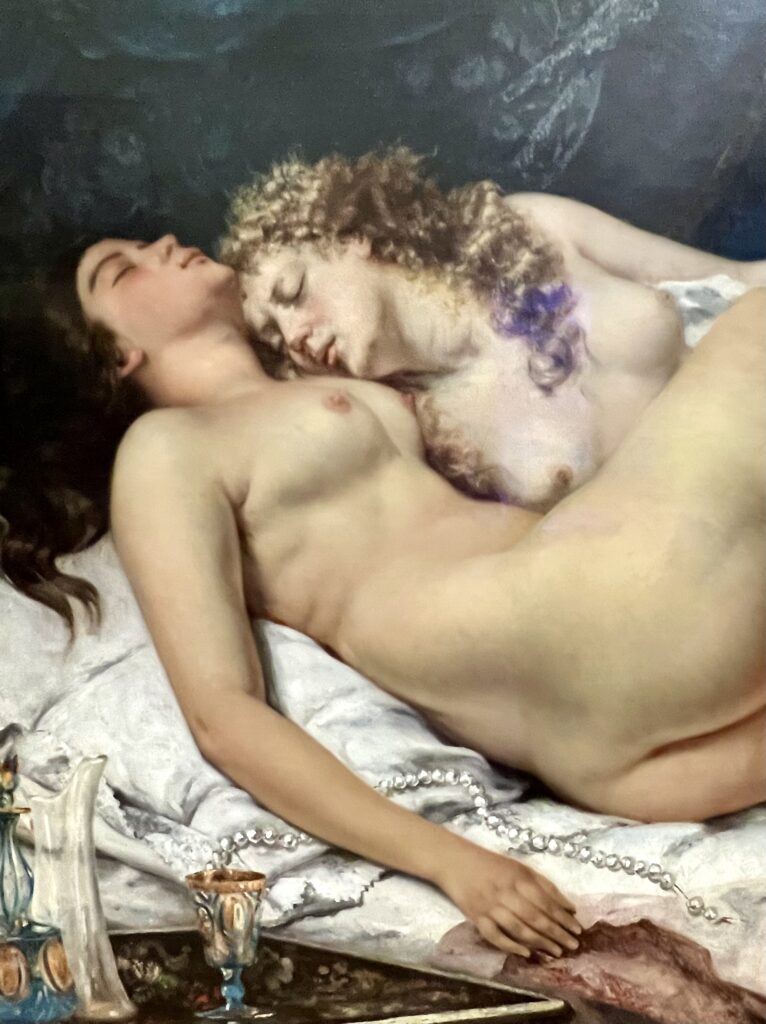
The collection includes artists as diverse as Rembrandt, Fragonard, Delacroix, Cézanne, Courbet, Corot, Monet, Rodin, Sisley, Pissarro, and many others.
There’s also a section dedicated to Roman and Greek art and some splashes of Post-Impressionism with Gauguin and Cezanne paintings. The museum also hosts special exhibitions featuring modern art, photography, and fashion.
The cafe is excellent too, if you need a break for brunch or lunch. If the weather is good, you can eat in the garden or under a frescoed colonnade.
Here’s my complete guide to the Petit Palais.
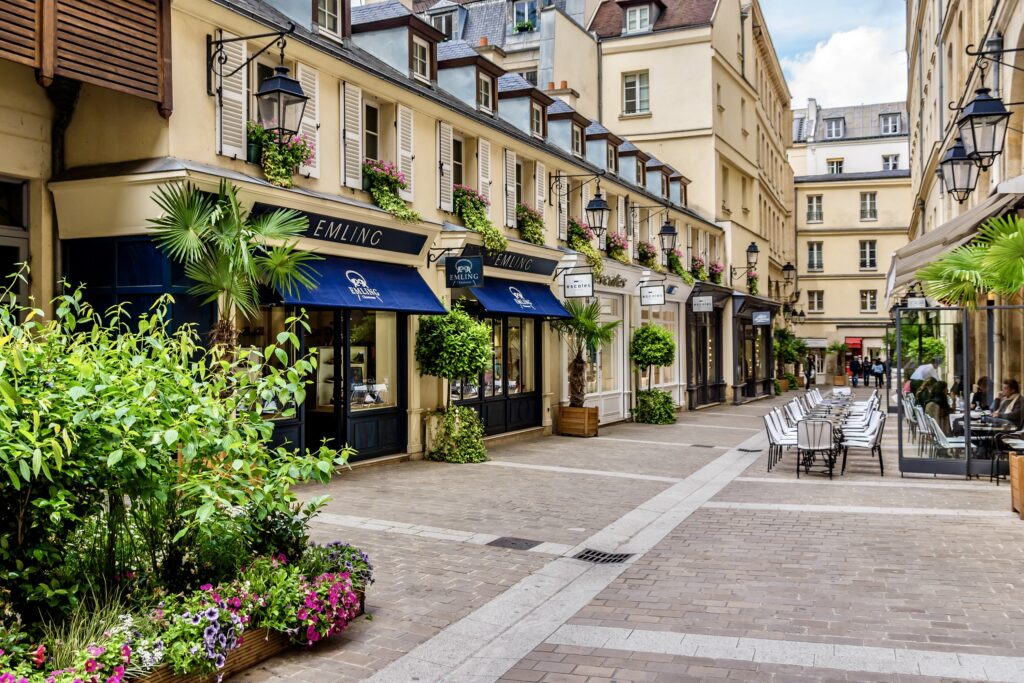
6. Rue Royal & Le Village Royale
Rue Royal is one of Paris’ toniest streets. It stretches from the Place de la Concorde to La Madeleine Church.
As you stroll down the street, you can pop into the charming Village Royal. It’s a chic passageway with its luxury shops and brasserie. In the winter, it’s lit up to dazzling effect.
Also just off Rue Royal is Rue St. Honore. It’s a fairly long street that leads from Rue Royal to the Palais Royal. It’s one of Paris’ best shopping streets , with high end designer stores.
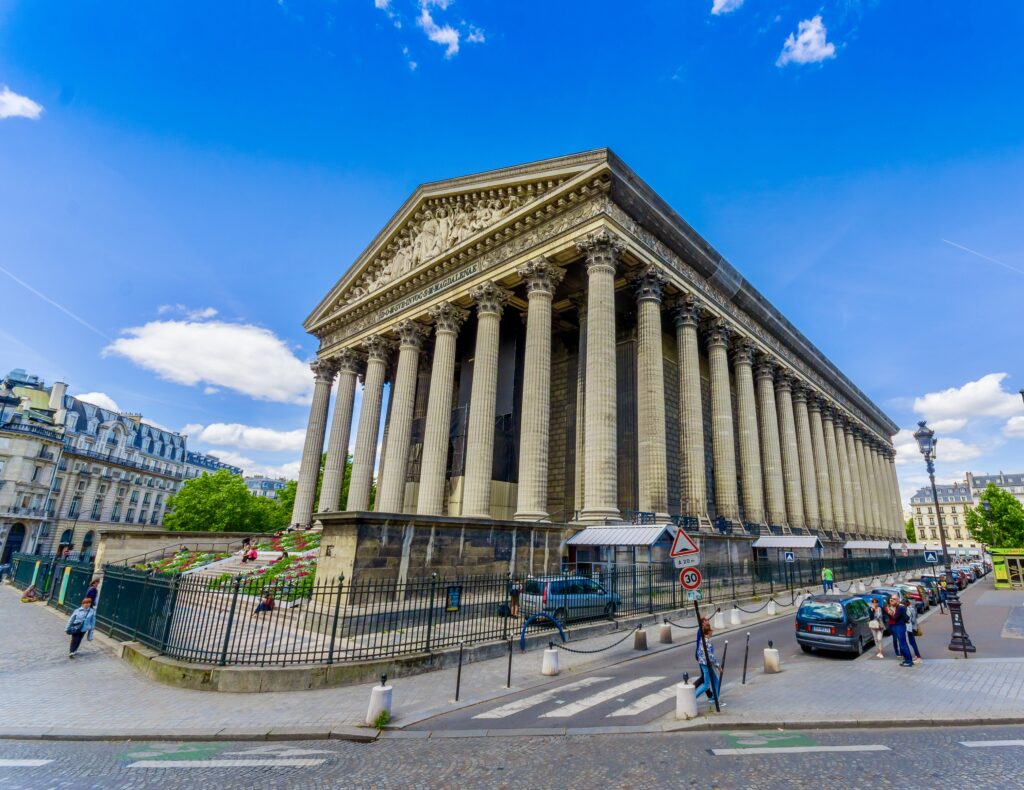
7. La Madeleine Church
La Madeleine Church is one of the most famous monuments and best things to do in the 8th arrondissement. Built by Napoleon, it looks more like a monumental Roman temple than a church
The Neo-Classical exterior is encircled by 52 Corinthians columns and statuary. It’s set on a pedestal to make the church seem more imposing.
The interior is a bit stark and dark. There is a single nave with three three large coffered domes, beautiful marble floors, and gilded chandeliers.
The church is also a veritable museum of French Romantic era sculpture. Probably the most famous statue is the Baptism of Christ by Francoise Rude.
The church is currently undergoing restoration and is completely free to visit. Here’s my guide to La Madeleine.
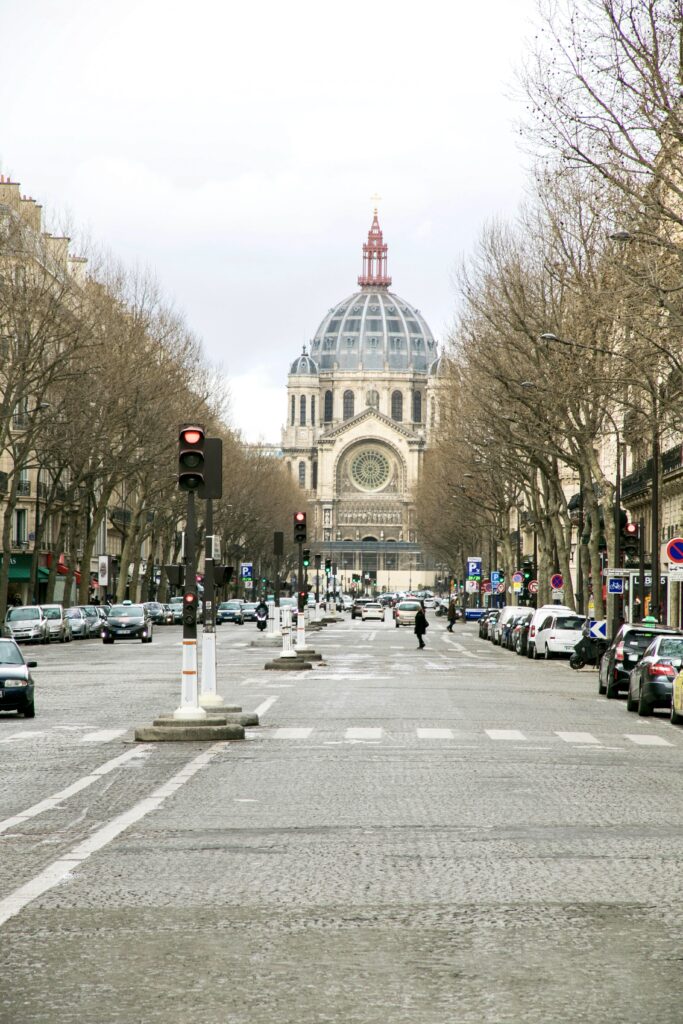
8. Saint Augustin Chuch
This lovely and overlooked church is on Boulevard Malesherbes in the 8th arrondissement.
It’s a Byzantine and Romanesque style church, built in 1860-71 and recently renovated. Very distinctive, it was built with a metal framework and covered with stone. The architect was Victor Baltard, who pioneered building with steel.
The church has a very narrow facade, with a large gilded rose window and frieze of Christ and the apostles across the front. The 100 meter high dome was inspired by St. Paul’s Cathedral in London.
Inside, there’s a long narrow nave and no side aisles. You can actually see the steel frame. You’l find the usual stained glass, paintings, and chapels.
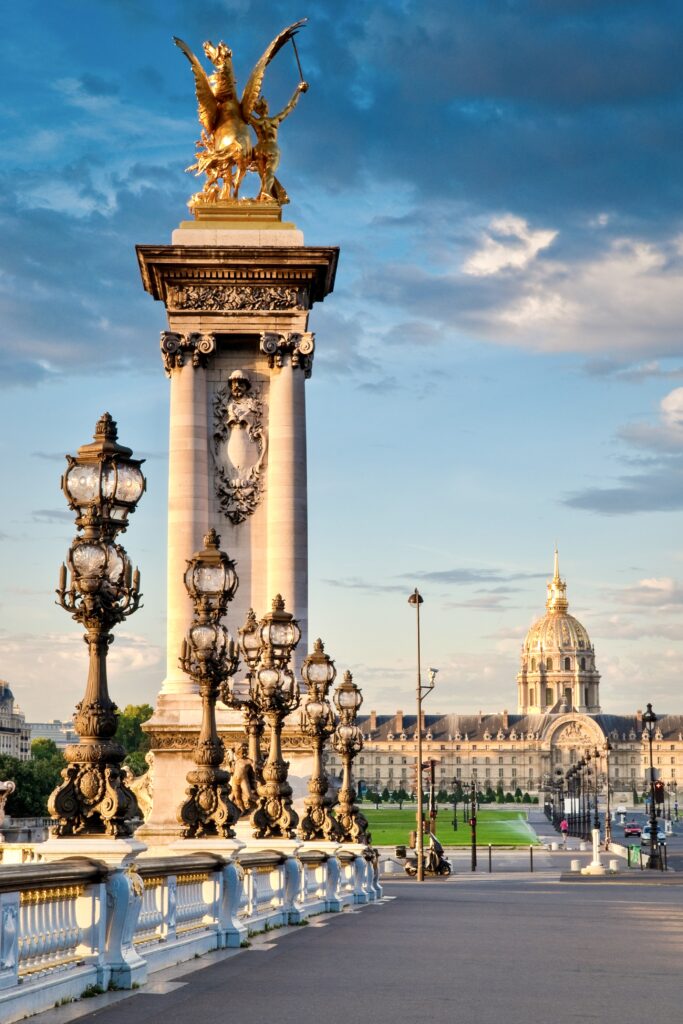
9. Pont Alexandre III
The Pont Alexandre III is the most elegant bridge in Paris. A fine example of Art Nouveau architecture, it was built and opened for the 1900 World Fair.
Much of its beauty comes from the gold statues and candelabras adorning it. The winged horses symbolize the arts, sciences, commerce, and industry.
The bridge is named for Tsar Alexandre III, who completed the Franco-Russian Alliance in 1892. The bridge was thus a symbol of the friendship between France and Russia.
The bridge is one of the greatest feats of architectural engineering from the latter part of the 19th century. It has a single low slung steel arch (to not block the views). The four pillars hosting the horses stand at 17 meters high, providing a counter-weight to the bridge’s arch.
With the Eiffel Tower in the background, it’s a popular space to take photos. Underneath the bridge, you’ll find Faust, a popular bar, restaurant, and club.
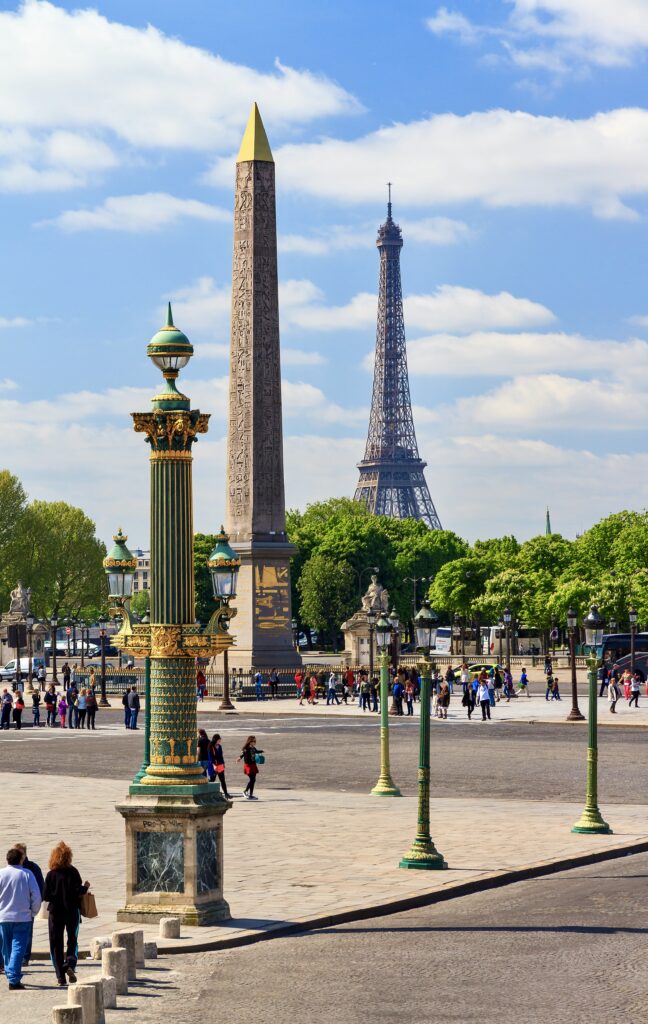
10. Place de la Concorde
When you stand in the Place de la Concorde, Paris spreads around you. You have views of the Eiffel Tower, the Seine, and the Champs-Élysées. It’s definitely one of the best things to do and see in the 8th arrondissement.
First laid out in 1755, the square was originally named after King Louis XV. But its royal associations meant that it took center stage during the French Revolution. Louis XVI was the first to be guillotined there in 1793.
During the following two years, 1343 more people (including Marie Antoinette, Danton, and Robespierre) also lost their heads in the square.
When the Reign of Terror ended, the square was given its current name in the hope that it would become a place of peace and harmony.
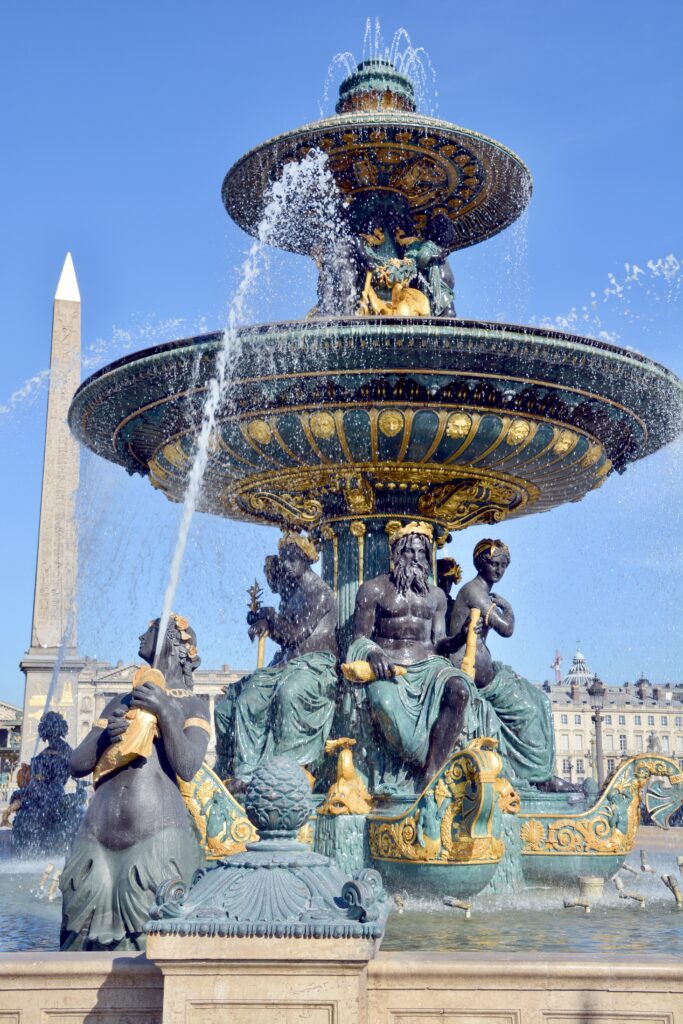
The corners of this landmark square are marked by eight statues representing what were once the largest cities in France.
The square’s two fountains were completed in 1840 during the reign of King Louis-Phillipe. They both feature a stone basin, where six tritons with fish spout water.
At the square’s center is the 3,300 year old Obelisk of Luxor, a diplomatic gift to France. The 72 foot obelisk once stood by Ramses II’s Temple of Luxor in Egypt.
Its glittering gold top is a recent addition from 1998, replacing one that was stolen. A bronze plaque in front of the obelisk memorializes the place where the guillotine once stood.
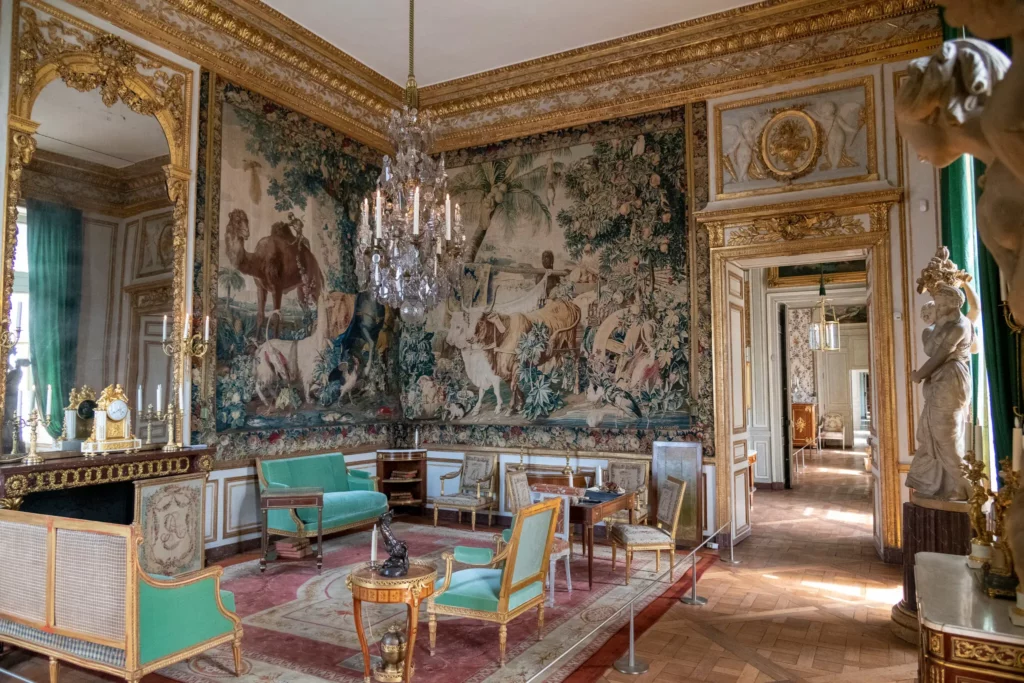
11. Hôtel de la Marine
The Hôtel de la Marine is another new museum in Paris, just opening in 2021. It’s housed in a grand Neo-Classical palace on the Place de la Concorde,
It was designed and built between 1757 and 1774 by the architect Ange-Jacques Gabriel. Louis XV’s superintendent had a grand suite of rooms there.
The museum can now be visited for the first time in almost 250 years after a meticulous $157 million renovation. 200 of France’s finest craftsmen were hired to restore it to its former to its Louis XV splendor.
Today, visitors can embark on an immersive visit of the sumptuous apartments, complete with furnishings and state rooms that provide access to the loggia overlooking the Place de la Concorde.
The elegance quotient is off the charts and an audio guide offers colorful historical anecdotes.
Click here to book a skip the line ticket.
12. Chapelle Expiatoire
The Expiatory Chapel is another one of the best things to do in the 8th arrondissement for history buffs. It’s located in the charming Square Louis XVI.
The chapel was built in 1816-26 to commemorate King Louis XI and Marie Antoinette, who were guillotined in 1793 during the French Revolution.
Louis XVI was buried here in what was then the cemetery of La Madeleine Church. (The cemetery was subsequently moved to the Paris Catacombs.)
After the restoration of the Bourbon monarchy, Louis XVIII had the bodies moved to the royal mausoleum of the Basilica-Cathedral of Saint-Denis.
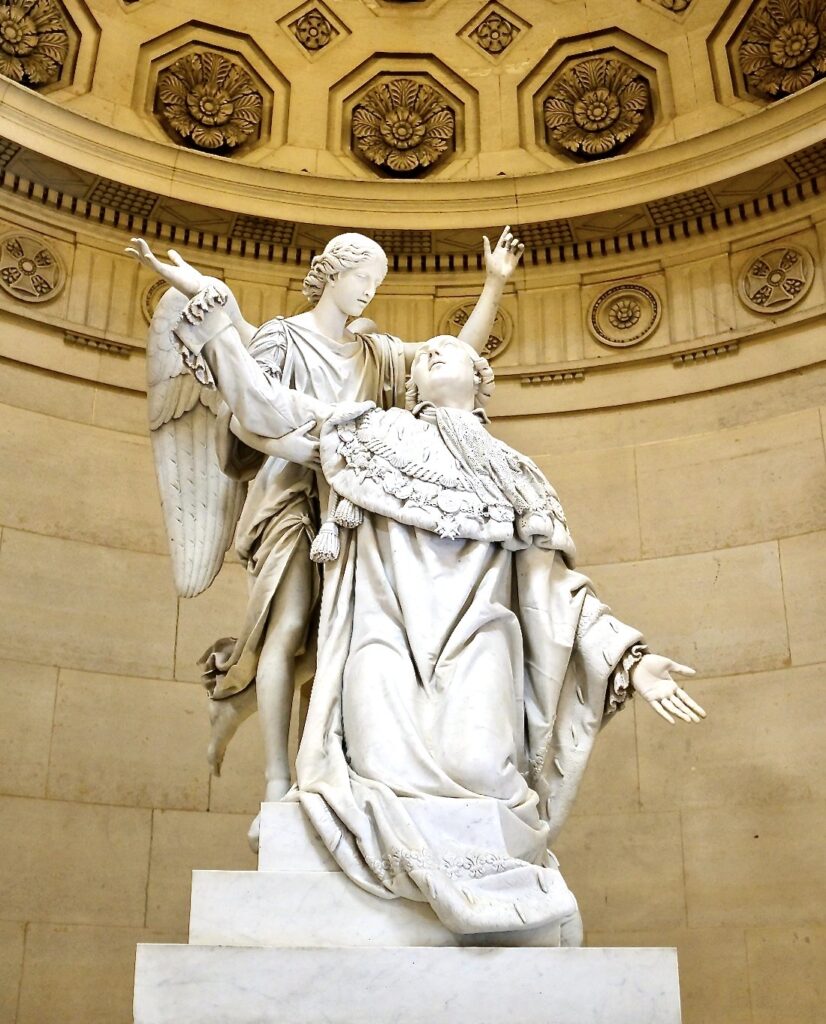
In 1816, the king paid to build the Expiatory Chapel to atone for the sin of killing the king and his wife.
The architecture is Neo-Classical in style and modeled on a Greco-Roman necropolis. Each side of the courtyard is lined with a nine arch arcade.
Inside, there are statues of Louis XVI and Marie Antoinette. The altar in the crypt is in the shape of a tomb and is on the exact site where Louis XVI was originally buried. Each year, a commemorative mass is held there.
The chapel is a hidden gem in the 8th where you can escape the crowds. Today, the exterior is perhaps in need of a power wash.
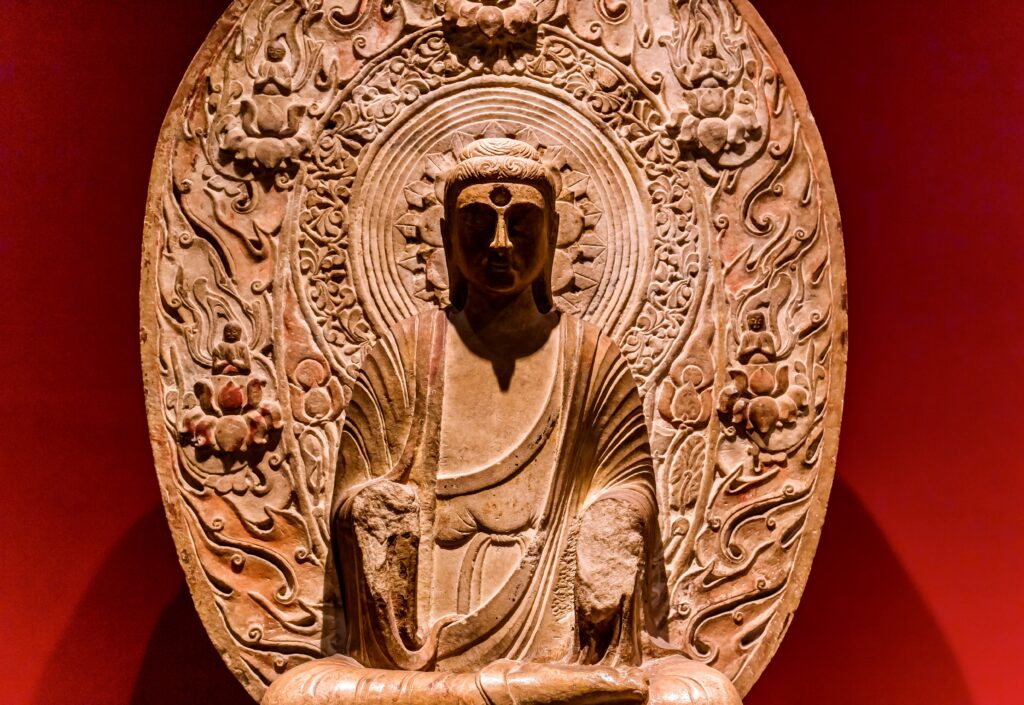
13. Musee Cernuschi
The Cernuschi Museum has one of the most important collections of Asian art in Paris. It’s housed in a beautiful mansion in the 8th arrondissement built in 1898.
The Cernuschi boasts a 10,000 piece collection. It includes ancient bronzes, burial figures, rare Buddhist sculptures, and sculptures collected by its benefactor Henri Cernuschi.
There are some exquisite Chinese figures from the 4th century B.C.
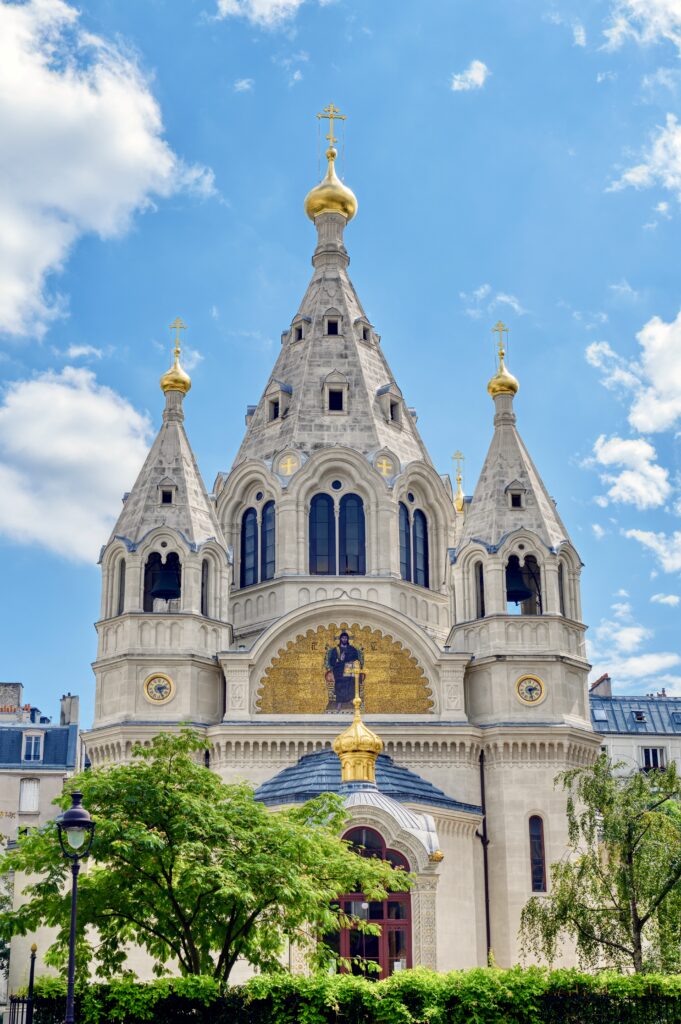
14. Alexander Nevsky Cathedral
Listed as a historic monument in 1983, the Nevsky Cathedral is Paris’ most famous Russian Orthodox Church. The church was consecrated in 1861 and partially funded by Tsar Alexander II.
It’s dedicated to Grand Prince Alexander Nevsky, who was canonized for being a humane ruler and for his great military success.
The church has a Greek cross plan. The facade has gold mosaics above the entrance and five cupolas “gilded like the flames of candles.”
The Nevsky Cathedral is famous as the place where Pablo Picasso married the Russian ballerina Olga Koklova.
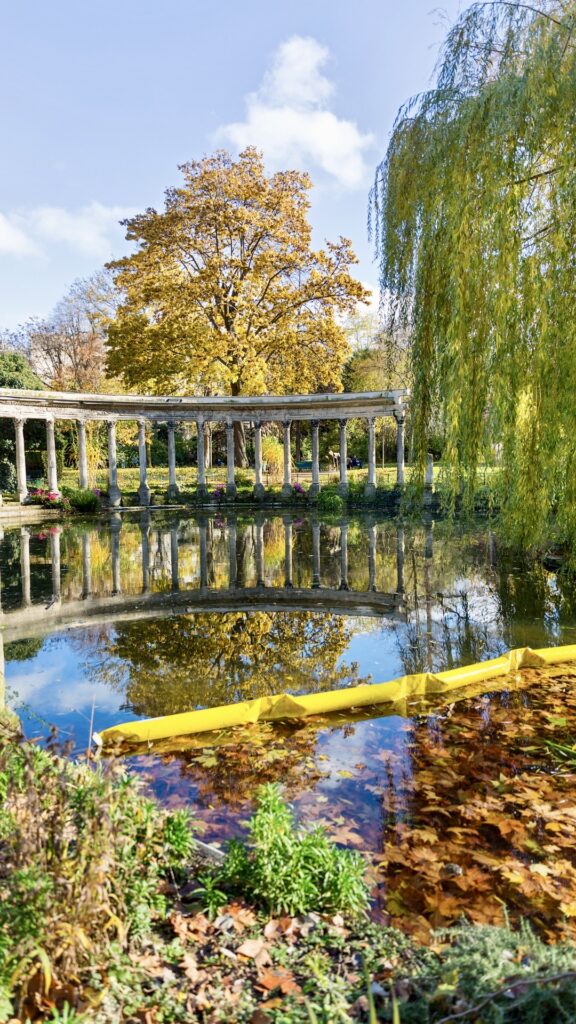
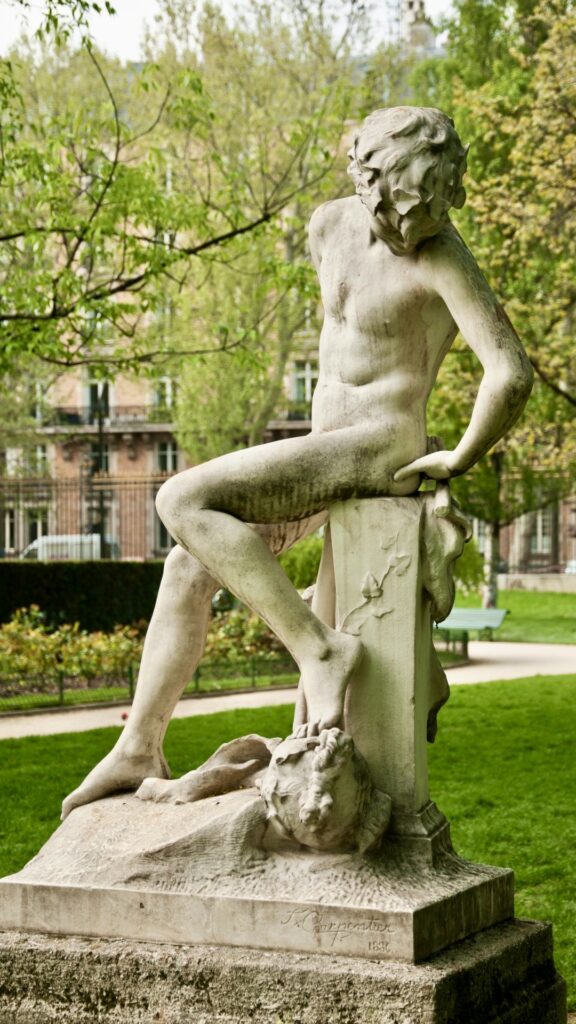
15. Parc Monceau
Dating from the 17th century, Parc Monceau is one of the most elegant gardens in Paris. It’s full of trees and flowers.
A beautiful Renaissance colonnade with Corinthian columns is set on a large pond. It reminded me of the Maritime Theater in Hadrian’s Villa Adriana outside Rome.
Parc Monceau is also full of mysterious follies and romantic ruins. One of the most curious is a pyramid with a doorway flanked by Egyptian heads.
The pyramid is the work of the Freemason and architect Bernard Poyet. It’s probably a Masonic symbol of immortality.
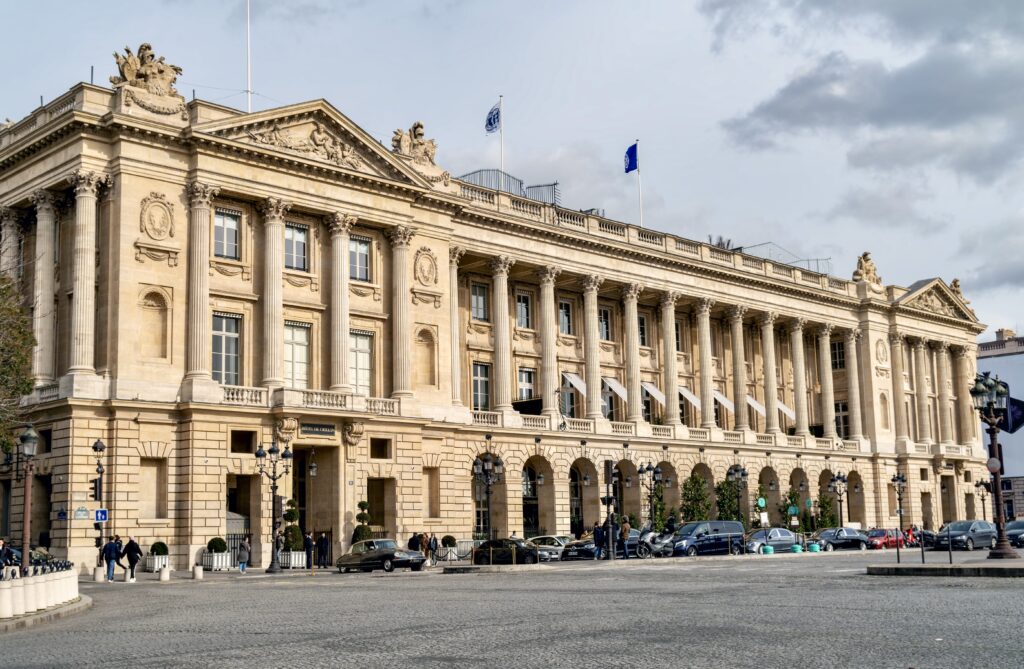
Where To Stay In The 8th Arrondissement
As you might expect, there are some lovely places to stay in the 8th arrondissement.
Hotel Vernet is a Belle Epoque mansion turned into a hotel with a contemporary interior. La Reserve is hotel and spa housed in a Haussmann-style mansion on the tree-lined Avenue Gabriel.
For a real boutique experience, you can check out Hotel Splendide Royal. It’s a tiny luxe hotel in a townhouse with a white and cream aesthetic.
Of course, there’s always the luxury showstopper, the Hotel de Crillon. It’s a 5 star hotel on the Place de la Concorde with Neo-Classical detailing and crystal chandeliers. The hotel is so fancy that one of its Belle Epoque rooms is on display at the Met in New York City.
And the Four Seasons George V is a stunning Art Deco hotel just steps from the Champs Elysees. It has three Michelin starred restaurants and Louis XVI decor.
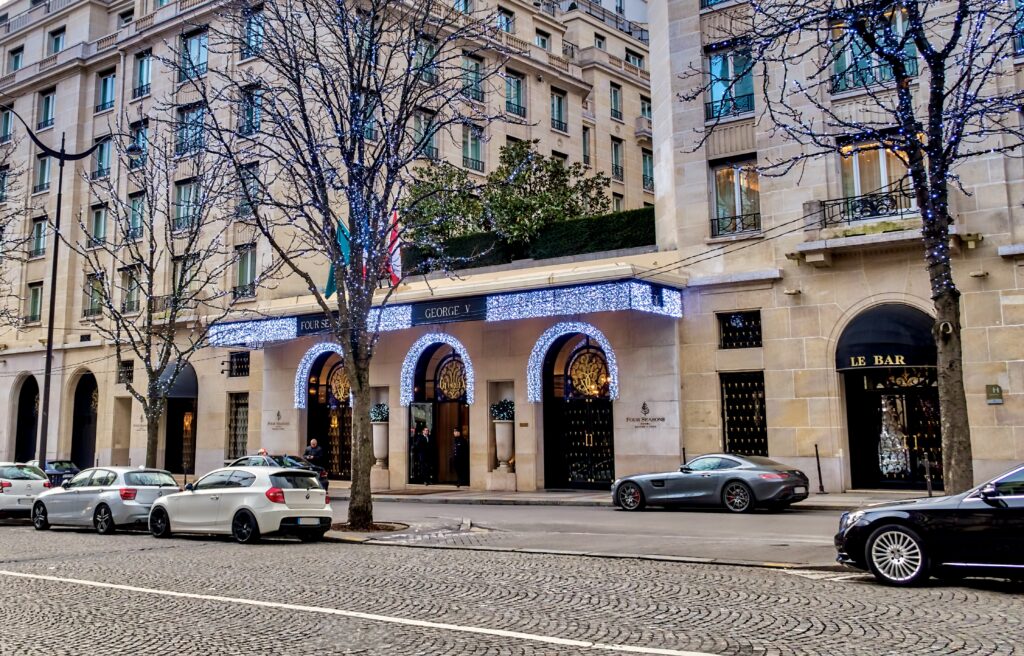
The 5 star Hotel Elysia just off the Champs Elysees recently got a chic makeover. The size and luxury of the rooms are top notch.
I hope you’ve enjoyed my guide to the best things to do in Paris’ 8th arrondissement. You may enjoy these other Paris travel guides and resources:
- 5 Day Itinerary for Paris
- 3 Day Itinerary for Paris
- 2 Day Itinerary for Paris
- 1 Day in Paris itineraries
- Tips for Planning a Trip to Paris
- Tourist Traps To Avoid In Paris
- Top Attractions in Montmartre
- Top Attractions in the Latin Quarter
- Top Attractions in the Marais
- Best Museums In Paris
- Hidden Gems in Paris
- Guide to the Opera District
- Secret day trips from Paris
If you need a guide to the 8th arrondissement, pin it for later.

